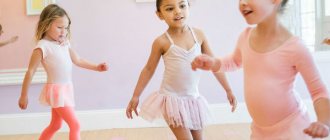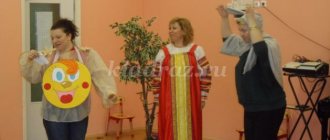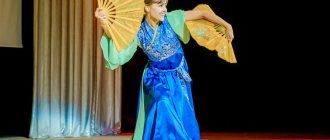Setting goals correctly
You need to decide in advance why exactly you are sending your child to dance. On the one hand, you can limit yourself to general physical and aesthetic development, and on the other hand, you can aim for serious achievements in the form of victories at city, regional and even international competitions. A child’s passion for dancing may well develop into a full-fledged professional career; the main thing is not to discourage the child from doing what he loves. In this regard, it is important to choose a competent trainer; not only the quality of training, but also the correct motivation depends on him. A good teacher knows exactly not only how to get the best results from students, but also how to interest them. In addition, after a trial lesson, he will be able to draw conclusions about the child’s potential in the chosen dance direction.
Which dance direction should I choose?
The choice of dance direction and school depends on the age and character of the child. This can be classical ballroom dancing or various genres of modern choreography. Unlike classics, modern choreography does not require a partner, complex regulations and costumes, which is why modern, hip-hop, R'n'B, breakdancing, jazz-funk and modern jazz, street jazz and others are so popular directions.
Already at the age of 5, it becomes clear what kind of temperament a child has, what kind of music he likes, how well he adapts and interacts in a team. It is necessary to choose a dance direction taking into account the wishes of the child, since the ideas of generations about beauty are very different. In the end, you can always try different styles of dancing, and only then make a choice.
Dance club program “Dance Kaleidoscope” work program on the topic
Municipal preschool educational institution "Ryabinka"
Dance club program
"Dance Kaleidoscope"
Educator
Buryakova N.V.
2014
Explanatory note
The content of this program includes musical and psychological training for children 4-5 years old, developing will, attention, mobility and flexibility, also aimed at developing musical abilities, creative imagination, fantasy, the ability to improvise in movement to music, which requires free and conscious control of the body. Moving from simple to complex, from children's songs to symphonic works, the child gradually becomes familiar with the world of beauty, passing through music, the complex world of feelings and images, while playing at the physical, visual and emotional levels with the specific language of musical expressiveness.
The variety of compositions in terms of direction, complexity and intensity of movements allows them to be used in any form of organizing work with children, from morning exercises to holiday matinees. The repertoire used within the program is musically expressive, exciting, awakens fantasy and imagination, develops the expressive capabilities of the body and at the same time is accessible for performance.
The most important indicator of the success of musical and rhythmic education of a child aged 4-5 years is interest in the very process of movement to music, expressiveness of movements and the ability to convey the character of music and a playful image in plasticity. With insufficient coordination, dexterity and precision of movements (which at this age corresponds to the norm), the expressiveness of children's plasticity reveals creative talent and musicality.
Goals and objectives of the dance club
The main goal of the dance club is the physical activity of preschool children.
Main goals:
- develop strength, endurance, agility, flexibility, coordination of movements, the ability to overcome difficulties, strengthen the will;
- improve children's health;
- contribute to the development of a sense of rhythm, tempo, performance skills in dance and artistic taste;
- form beautiful manners, gait, posture, expressiveness of body movements and poses;
- relieve shyness, tightness, complexes;
- teach to rejoice in the successes of others and contribute to overall success.
Organization of dance club activities
The work of the dance club is based on common principles and ensures the integrity of the pedagogical process.
Classes in the dance club are conducted in accordance with the schedule of classes, taking into account the age characteristics of the students, as well as taking into account the requirements of SanPiN 2.4.1.2660-10.
Classes for children are held in the music room once a week. Lesson duration - 15-20 minutes.
To report to the parents of students for the quality of the educational service provided, the head of the dance club holds open events at least once every six months.
Documentation of the dance club leader
The head of the dance club is responsible for the availability, content and culture of maintaining the following documentation:
- notebook for keeping track of children's dance club attendance;
- long-term calendar plan for the dance club;
- the result of identifying the levels of development of children’s motor activity at the beginning and end of the school year;
- map of preschool children's participation in events.
Club work plan
| March 1 lesson | "Waiting for Spring" | Consolidating the ability to reproduce rhythmic pulsation, a simple rhythmic pattern, and a downbeat in movement. Consolidating the skills of dance movements: stomping step, half-squat, spinning on a stomping step | Learning spring round dances. Dance “Sun Rays”, “Crows”, “Sparrows”, “Piglets”. Musical outdoor games of children's choice |
| 2 class | "Musical gifts for mom and grandma" | Development of skills to perform dance movements for demonstration and independently. Learning dances with mothers. Strengthening the ability to start and finish movements with music | Dance “Buttons”, “Two Drops”, exercise with flowers “Waltz” Kishko, pair dances with mothers as shown |
| Lesson 3 | "Mom's smile" | Repetition of dances and exercises learned for the holiday. Creating conditions for independent performance of the holiday repertoire | Dance “Buttons”, “Two Drops”, exercise with flowers “Waltz” Kishko, pair dances with mothers as shown |
| Lesson 4 | "Meeting the Birds" | Strengthening the skills of fast running, jumping on two legs, soft springs | Exercise “Sparrows” (music by T. Vilkoreiskaya), “Birds and Crows”, Repetition of spring round dances. |
| April 1 lesson | "Drips and Streams" | Improving light running skills, the ability to start and finish movements along with music, and perform lane changes in accordance with parts of the music | Exercise “Streams” (easy running - music by K. Weber). Repeating paired dances at the request of the children |
| 2 Class | "Spring Breeze" | Improving light running skills, the ability to start and finish movements along with music. Strengthening the ability to perform swinging movements with your arms (on a spring) | Hand exercise “Blow and Wind”, paired and character dances with formations of two or three figures. Construction of exercises in easy running “Streams”. Outdoor games with music. |
| Lesson 3 | "Meeting dear guests" | Development of skills to perform movements together with an older child (development of communication skills) Performing movements to demonstrate, improvising movements in accordance with the nature of the music | Dance games “Find yourself a partner”, “Colorful game”, “Birds and Crows”, pair dance for 2-3 figures (optional) |
| Lesson 4 | "Our Favorite Toys" | Improving the ability to perform simple dance movements: half-squat for boys, twirling in pairs, alternately placing legs on heels, twirling in place, etc. | Dance “Tumbler”, “Dolls and Bears”, “Teddy Bear”. Repetition of familiar figurative play compositions and outdoor games. |
| May 1 lesson | "Favorite songs for kids" | Improving the ability to perform simple dance movements as demonstrated by an adult when playing children's songs | Dance “Buttons”, “Two Drops”, “One, Palm” music by E. Zaretskaya. Repetition of familiar couple dances (optional) |
| Lesson 2 | "Feast of the First Flowers" | Improving the ability to swing your arms (on a spring). Consolidating the skills of changing formations in space, moving in a circle, scattered, “snake” behind the leader | “Magic Flower” music by Y. Chichkov (or another of your choice). Repetition of familiar dances and figurative musical and rhythmic compositions (optional) |
| 3 class | "Festival of spring rays" | Consolidation of the skill of easy running, stomping step, jumping on two legs. Consolidating the skills of changing formations in space, moving in a circle, scattered, “snake” behind the leader | Exercise with flowers and green twigs (music of your choice), figurative and playful compositions “Leopold the Cat”, “Piglets”, “Birds and Crows” |
| Lesson 4 | Dandelion Festival" | Fostering children's sustainable interest in musical and rhythmic activities. Expansion and improvement of motor skills and abilities. | “Dance with Flowers” (repetition). Musical and rhythmic composition “song about summer” music. E. Krylatova |
Monitoring children's development
The main method of pedagogical diagnostics is systematic observation of children’s manifestations in musical and rhythmic activities, assessment of their performance of various game tasks. During the observation, the teacher evaluates the children’s manifestations, comparing them with each other, focusing on the best indicators identified for a given age (in a given group).
Card for diagnosing the level of musical and psychomotor development of a child
| Child's name | Diagnostic time frame | ||
| options | Beginning of the year | Mid year | The end of the year |
| Interest and need for musical movement | |||
| The ability to reflect character in movement and use basic means of expression) | |||
| Emotionality (expressiveness of performance) | |||
| Creativity (ability to improvise in movement to music, originality, variety of movements used) | |||
| Development of motor skills (Availability of various types of movements in accordance with the program and content) | |||
| Mobility (lability) of nervous processes (the ability to switch from one movement to another in accordance with music, change the direction of movement, rearrange) | |||
| Formation of correct posture | |||
| Formation of spatial orientation skills |
Assessment of children 4-5 years of age
High level – the ability to convey the character of the melody, independently start moving along with the music, change the movement for each part of the music
Intermediate level - the movements express the general character of the music; the tempo, beginning and end of the movement to musical accompaniment do not always coincide.
Low level - the movement does not reflect the nature of the music and does not coincide with the tempo of the rhythm, as well as with the beginning and end of the piece
Emotionality – expressiveness of facial expressions and pantomimes, the ability to convey in facial expressions, posture, and gestures a diverse range of feelings, based on the music and the content of the composition (fear, joy, horror, surprise, delight, anxiety).
Emotional children often sing along while moving, say something, and wait for the teacher’s assessment after the movement. In unemotional children, facial expressions are poor, movements are inexpressive, assessed by external manifestations “+”, “- “
Creativity is the ability to improvise to familiar and unfamiliar music based on movements mastered in classes, as well as to come up with your own, original steps. The assessment is specified depending on the age and level of training of the child. Creative talent is manifested in special expressiveness, non-standard plastic means and the child’s enthusiasm for the very process of moving to music. The degree of expressiveness and originality is also assessed by the teacher during the observation process: “+”, “-“.
Development of motor skills - mastering various types of movements in accordance with the program content: basic movements (walking, running, jumping movements), general developmental (for various muscle groups), imitation (figurative play), dancing, dancing, gymnastics with and without objects . The quality and confidence of performing various movements, the variety and volume of movements performed are assessed.
Mobility (lability) of nervous processes is manifested in the speed of motor reaction to changes in music. The norm, the standard, is the compliance of the execution of exercises with the music, the ability to subordinate movements to tempo, rhythm, dynamics, etc. And in case of pronounced difficulties “- “.
The formation of correct posture is assessed on the basis of observations and medical data - the norm is “+”, the problem is “-“.
The formation of spatial orientation skills is assessed on the basis of observations of the execution of various formations in accordance with age capabilities, the ability to perform movements in the desired direction (right-left, forward-back), and the ability to perform movements with the right and left hand (leg).
As a result of the diagnosis, the teacher can calculate the average total score for a general comparison in the child’s development over a certain period of time, and build a diagram or graph of development indicators. Pedagogical diagnosis is essentially a subjective assessment. Therefore, it is not the number of points that is important, but the severity of the dynamics of development.
We are waiting for the result
You should not listen to teachers who promise to make your child almost a star in just a few lessons. Even the most powerful creative potential is limited by physiology, so progress will be gradual. As a result of regular training in the dance section, the child will learn to control his body, develop a muscular corset, and become resistant to physical activity. In addition, in dance, children will learn to throw out energy and emotions, to realize themselves.
Other important skills that develop gradually include persistence and determination. Almost all children go through an adaptation stage, when the novelty of sensations disappears and interest in activities disappears. It is important to overcome this stage, since the child must understand that results in any endeavor can only be achieved through hard work.





